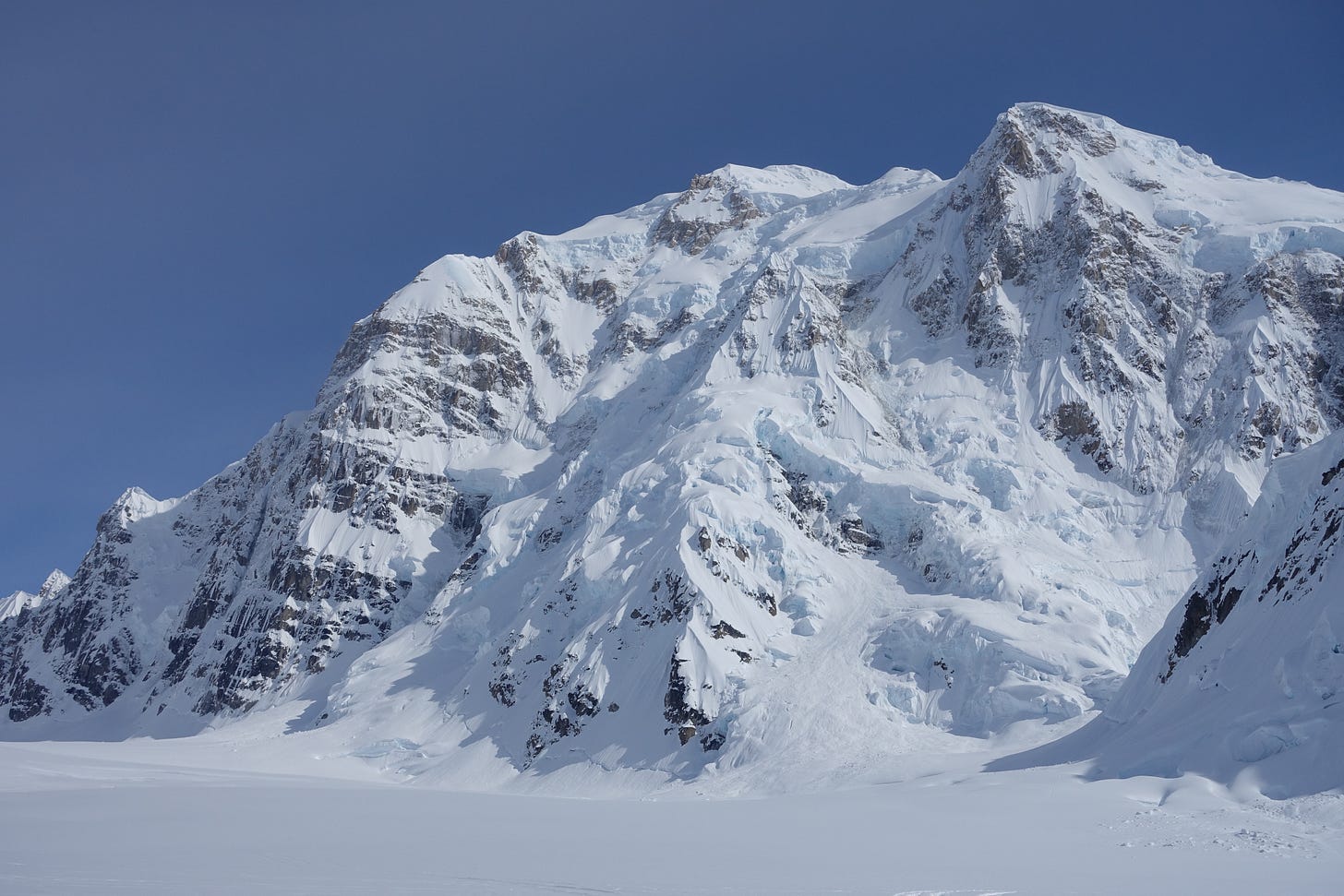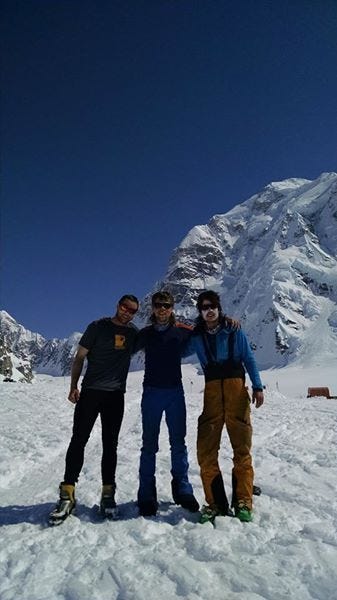In late April 2015 I took my first trip to the Central Alaska Range. Over the next week and a half Jeff Longcor and I climbed the East and Southwest Ridges of Mt. Francis, and the ice climb ‘Bacon and Eggs.’ Then Jeff, Pete Mamrol, and I climbed the North Buttress of Mt. Hunter to the summit over four days. The climb was successful because of great weather conditions but more importantly because these guys were my partners. We communicated well and were honest with each other about our personal needs, and we ended up with a breakthrough achievement
Many thanks to Cabot Cheese, Teddie Peanut Butter, and the Earle Family Farm for their support of our trip! Cheese, chunky PB, and maple syrup are great fuel for hungry climbers.
If you’re unfamiliar with the North Buttress route, read Clint Helander’s great description on Mountain Project.
The first day I spent with Jeff was also my baptism into the world of ice climbing. In the winter of my second year in college at Tufts, he invited me to climb on the frozen seeps of a fifteen foot tall road cut in Franconia Notch. We built our anchors off clumps of inch thick paper birch tied together, and though I thought I was going to die the whole time I climbed as many times as I could before my forearms blew out.
After that, there was nothing I wanted to do more, so Jeff took me out more. I don’t know why he liked to climb with people who were no good at climbing, but he seemed to genuinely enjoy it. I kept going back to climb with him and slowly got better – from Cannon Cliff to Mt. Washington, Mt. Washington to Katahdin, Katahdin to Lake Willoughby.
While I was in grad school we stopped climbing together as much. I focused on getting fitter – I lifted weights and dedicated dawn patrols to toprope laps on vertical ice. I became a decent ice climber. We still got out now and again, but our relationship changed. I envisioned him more as a close friend and reliable partner and less the leader of a motley crew of newbie climbers.
Last fall I took off to spend time out West. Then I came back to the Northeast and started guiding in Conway. In January of this year I convinced Jeff that he and I needed to go to Alaska, and that it was important for me to take my first trip there with him because he’d showed me the ropes. He committed whole hog by using all his vacation time and then some.
I met Peter while I was in grad school, I don’t remember exactly when. He was quiet guy in a mineralogy course I was a teaching assistant for, and when we spoke after lab one day, it was clear that he just wanted to be in the mountains. All the time. I learned that, in high school, he’d skip nordic practice to spend afternoons touring in the Chugach. When he visited his sister in Bozeman they’d go climbing in Hyalite every day. He’d just gone to the Bugaboos last year, and really wanted to go back. I tried to argue that the Northeast has great climbing, too, but he wouldn’t have it.
Pete opted to go on Dartmouth’s roving geology field camp, which I worked on. We ran and climbed a bit while driving around the West, and we got to know each other much better. I flew back east in September, and drove out to Yosemite for a month. Then I went to Zion. In November, I picked him up in Flagstaff, and we ran the Grand Canyon Rim-to-Rim-to-Rim. Three days later we were in Red Rocks, where I hobbled between climbs while Pete onsighted most of them. We visited Indian Creek then drove north to go ice climbing in Bozeman. In the middle of December, I said goodbye and drove back east, while Pete went home to spend the winter working on the North Slope of Alaska.
And so it was when months later in the first days of May, Jeff, Pete, and I stood around a pile of climbing gear and food under the North Buttress of Mt. Hunter. Pete had flown onto the Southeast Fork of the Kahiltna Glacier the day after Jeff and I arrived, a week before. He thought we might be, as described by the staff of the flight service, “the goofy guys from New Hampshire.” I had no idea he’d be here. Jeff had no idea who he was. None of that mattered now, we decided.
Jeff took the first block, starting up over the bergschrund. After four pitches, to the base of the Twin Runnels, Peter led off. The first crux was a tricky iced up corner just below the Prow. Pete stopped sixty feet below this and built a belay. He stopped again just below the corner so Jeff and I could assemble a fortress from our backpacks. As he moved on, we cowered underneath our shelter while ice rained down from above.
My block started at the base of the Prow. The pitch was caked with snow, so I did a lot of scraping to reveal cracks. The corner offered engaging, steep climbing. After Jeff and Pete came up, I briefly described to them how to lower out and then climbed down and pendulumed onto the McNerthy Ice Dagger. After I climbed up and put them on belay, I was surprised to watch Jeff launch himself across the ice dagger, hollering as he swung back then forth above the Southeast Fork. Pete was clipped into a lower-out piece and didn’t take the ride. They climbed up and I climbed the rest of the block, finishing Tamara’s Traverse while the sun set over Foraker’s shoulder. We started chopping ledges into the first ice band and and crawled into our sleeping bags long after the sun had set. Jeff was the last in bed as he sorted the rack, boiled water, and got our food ready.
A few hours later Pete was off into the Shaft. Thirty feet up, the way was blocked by a substantial snow mushroom. I thought it might be the end of the line but Peter had a different idea. He climbed up to just below it and placed a nut to his left, then started chopping away. Jeff and I watched gobs of snow rain down. He chopped away for 20 minutes until the rope slithered upwards again. He’s through! While Pete was climbing, Jeff radioed down to basecamp to check on the weather report we’d missed the previous day. A storm forecasted to hit tomorrow had ‘fizzled out,’ deflected to the east. The new forecast called for a few more sunny days.
Pete styled his way to the second ice band, where Jeff took over after a quick pit stop. A flightseeing tour glided by on our level and we waved. Jeff led up through the Vision in a very verbal manner. By this point we were all bonkered, so Jeff handed the next pitch to Pete, and I finished off to the top of the third ice band. Thankfully there was enough snow that we didn’t have to chop ledges from ice.
The next day I led from the bivy. As I climbed the Come Again Exit my body tensed and relaxed. Everything felt tired. Can’t stop now. We had a ways to go to the top of the buttress; I broke trail. I’d set my eyes on a chunk of snow fifty feet above. I don’t have far to go now, not far at all. Can’t stop. When that one came I’d pick another target. Can’t stop. Not far at all. Eventually, I pulled onto the crest of the buttress and we grouped up.
Pete led on, breaking trail around a rock buttress. Then Jeff led for a while. Then I led for a while. Exhaustion hounded us. We discussed bivying in a hole, but no good hole appeared. We trudged on, forever up through the deepening twilight, until all of a sudden we were on top. After three minutes we went over and down onto the broad plateau below the summit. We built a snow wall and settled in for a cold night.
Dawn warmed us for the first time in three days. Clouds billowed off south, drifting slowly towards us. Rappelling was not an appealing option, but we had not brought a description of the descent off the West Ridge. Jeff recalled some details but we were uncertain of their accuracy.
I took out my phone to see if I had copied down any information about the descent. Thinking it was a long shot, I turned off airplane mode and was surprised to see we had good cellular service. I called a friend in Boston I knew would answer the phone. “Sam, think you could do me a favor?” He will never let us live it down.
A description of our descent plan in hand, we started down the West Ridge. We rappelled a few times over seracs to gain the top of the ridge proper. We descended into clouds to where we thought the Ramen Couloir started. Pete cleared some snow to build a thread, then found two pieces of cord frozen into the ice. Bingo.
Five foggy rappels later, the snow firmed up enough in the couloir to walk down the remainder. The cloud we were in lifted enough to reveal the glacier rising up before us, and we were back on a rope. A short walk uphill, three more rappels, and a short walk across avalanche cones and we were on the main fork of the Kahiltna.
On the walk back to basecamp we didn’t say much to each other. When we turned onto the Southeast Fork, everything was shrouded in clouds. But as we made our way up Heartbreak Hill, the clouds parted to reveal the summit of Hunter, then the North Buttress. Above us, a faint river of green light flowed in the night sky. The solstice was not far off, and I expect it was one of the last times the Aurora shone before the midnight sun rose.



